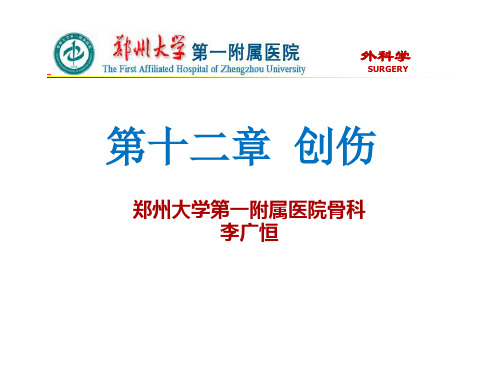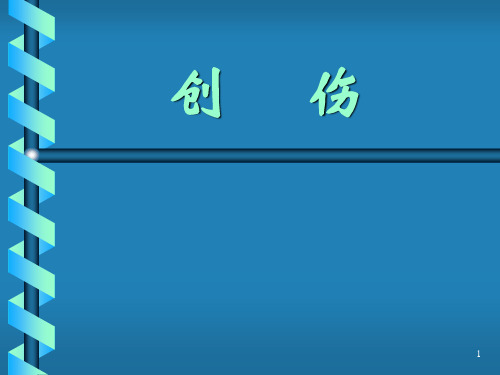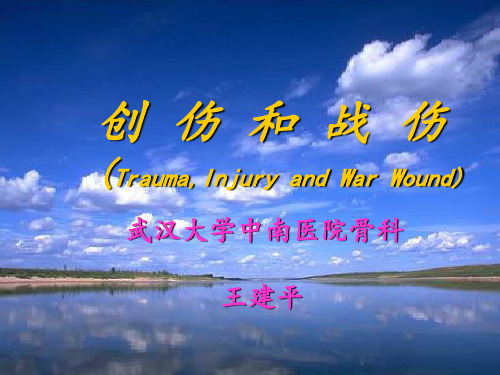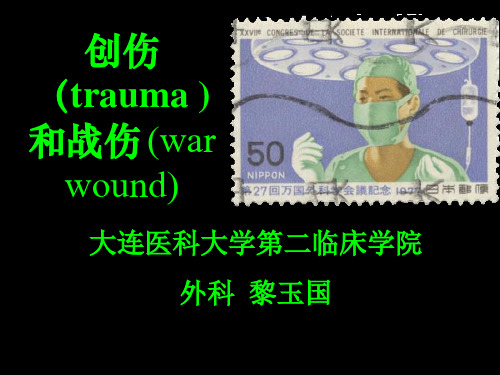《外科学》创伤与战伤(英文)
合集下载
第十二章 创伤和战伤

绷带:环形包扎、反折包扎、8字形包扎 三角巾的使用方法
外科学
SURGERY
环形绷带包扎法
最基本的方法,多用于手腕、肢体、胸、 腹等部位的包扎 方法:将绷带作环形重叠缠绕,最后用 扣针将带尾固定,或将带尾剪成两头打 结固定。
外科学
SURGERY
环形绷带包扎法
注意事项: (1)缠绕绷带的方向应是从内向外,由下至 上,从远端至近端。开始和结束时均要重复缠 绕一圈以固定。 打结、扣针固定应在伤口的上 部,肢体的外侧。 (2)包扎时应注意松紧度。不可过紧或过松, 以不妨碍血液循环为宜。 (3)包扎肢体时不得遮盖手指或脚趾尖,以 便观察血液循环情况。 (4)检查远端脉搏跳动,触摸手脚有否发凉 等。
外科学
SURGERY
搬运时的注意事项
搬运脊椎骨折的伤者,要保持伤者身体的固定。颈椎 骨折的伤者除了身体固定外,还要有专人牵引固定头 部,避免移动。 用担架搬运伤者时,一般头略高于脚,休克的伤者则 脚略高于头。行进时伤者的脚在前,头在后,以便观 察伤者情况。 用汽车、大车运送时,床位要固定,防止起动、刹车 时晃动使伤者再度受伤。对昏迷病人,应注意呼吸道 的通畅。
外科学
SURGERY
二、创伤病理
局部反应:创伤性炎症
原因:组织破坏、细胞变性坏死、微循环 障碍、微生物入侵、异物存留 表现:炎症反应
非特异性的防御反应:清除坏死组织、杀 灭细菌、促进组织修复
外科学
SURGERY
创伤的全身性反应
全身反应:
应激反应 全身多系统参与其中
外科学
SURGERY
外科学
SURGERY
失血的表现
一个成年人失血量在500毫升时,可以没有明 显的症状。 当失血量在800毫升以上时,伤者会出现面色、 口唇苍白,皮肤出冷汗,手脚冰冷、无力,呼 吸急促,脉搏快而微弱等。 当出血量达1500毫升以上时,会引起大脑供血 不足,伤者出现视物模糊、口渴、头晕、神志 不清或焦躁不安,甚至出现昏迷症状。
外科学
SURGERY
环形绷带包扎法
最基本的方法,多用于手腕、肢体、胸、 腹等部位的包扎 方法:将绷带作环形重叠缠绕,最后用 扣针将带尾固定,或将带尾剪成两头打 结固定。
外科学
SURGERY
环形绷带包扎法
注意事项: (1)缠绕绷带的方向应是从内向外,由下至 上,从远端至近端。开始和结束时均要重复缠 绕一圈以固定。 打结、扣针固定应在伤口的上 部,肢体的外侧。 (2)包扎时应注意松紧度。不可过紧或过松, 以不妨碍血液循环为宜。 (3)包扎肢体时不得遮盖手指或脚趾尖,以 便观察血液循环情况。 (4)检查远端脉搏跳动,触摸手脚有否发凉 等。
外科学
SURGERY
搬运时的注意事项
搬运脊椎骨折的伤者,要保持伤者身体的固定。颈椎 骨折的伤者除了身体固定外,还要有专人牵引固定头 部,避免移动。 用担架搬运伤者时,一般头略高于脚,休克的伤者则 脚略高于头。行进时伤者的脚在前,头在后,以便观 察伤者情况。 用汽车、大车运送时,床位要固定,防止起动、刹车 时晃动使伤者再度受伤。对昏迷病人,应注意呼吸道 的通畅。
外科学
SURGERY
二、创伤病理
局部反应:创伤性炎症
原因:组织破坏、细胞变性坏死、微循环 障碍、微生物入侵、异物存留 表现:炎症反应
非特异性的防御反应:清除坏死组织、杀 灭细菌、促进组织修复
外科学
SURGERY
创伤的全身性反应
全身反应:
应激反应 全身多系统参与其中
外科学
SURGERY
外科学
SURGERY
失血的表现
一个成年人失血量在500毫升时,可以没有明 显的症状。 当失血量在800毫升以上时,伤者会出现面色、 口唇苍白,皮肤出冷汗,手脚冰冷、无力,呼 吸急促,脉搏快而微弱等。 当出血量达1500毫升以上时,会引起大脑供血 不足,伤者出现视物模糊、口渴、头晕、神志 不清或焦躁不安,甚至出现昏迷症状。
创伤与战伤(尚剑)

创 伤的并发症
三、创伤的诊断(+)
原则:确定部位、性质、稳定、全身 改变以及并发症。
(一) 病 史 • 致伤原因 • 伤后症状及演变过程 • 既往史
(二) 体 格 检 查
• 全身情况:精神状态,面色,生命 体征。
• 根据病史或某处突出体征详细检查 • 开放性损伤,要观察伤口或创面,
注意创口位置,污染,出血等情况。
(三)论述:伤口的分类及其相应的处理方式? (四)分析思考题:
2 细胞增生:成纤维细胞,内皮细胞,新生血管等构成肉芽组织 充填组织间隙。原有的血凝块坏死组织等被吸收吞噬或排出。 肉芽组织内的胶原纤维增多,硬度↑强度↑肉芽组织→瘢痕。上 皮细胞从创缘向内增生,肌成纤维细胞使创缘周径收缩→伤口 愈合。
3 组织塑形:瘢痕内的胶原及基质被转化吸收,瘢痕软化,适应 功能需要。巨噬细胞及多种介质参与细胞的增生和组织塑形。
二、创伤后的病理变化及临床
局
病
部
理
变
化
全
身
血浆渗出,介质释放
创伤性炎症< 吸收 细胞增生 组织修复
应激反应:体温反应,炎症介质作用于体温中枢
内分泌变化,肾上腺素,抗利尿激素
代谢变化:糖原蛋白质脂肪分解 防御反应:免疫功能降低
三、创 伤 的 修 复 (※)
(一)、组织修复过程
1 纤维蛋白充填: 伤口和组织裂隙被血凝块充填,纤维 蛋白附加, 起到止血和封闭创面的作用。
• 闭合性创伤的处理 • 功能练习
五、小结
损伤与创伤的概念---分类与诊断的 关系---创伤后的变化(病理)与临床表 现---修复、急救及创口分类与处理。
六、复习题
(一)概念:1、创伤与损伤的关系? 2、一期(二期)愈合
医学课件外科学总论13创伤和战伤

脱水或手术
29
开放性创伤的处理
• 清洁伤口 (cleaning wound) • 污染伤口 (contaminated wound
清创术 • 感染伤口 二期(延期)愈合
异物存留
30
浅部软组织创伤 •挫伤 •刺伤 •切割伤
31
清创术 debridement
• 清洗去污 汽油/乙醚 肥皂液 盐水/冷开水
切口类型
Ⅰ类切口 Ⅱ类切口 Ⅲ类切口
切口愈合
甲级愈合 乙级愈合 丙级愈合
17
不利于创伤修复的因素
• 局部因素 : 伤口特点 (血运障碍
感染 异物存留或失活组织过多 缝合技术和材料 制动不够
• 全身因素 (年龄、营养、维生素、
(慢性疾病、 (激素水平 (心理压力
18
(四)创伤并发症
• 1.感染 • 2.休克 • 3.脂肪栓塞综合症 • 4.应激性溃疡 • 5.凝血功能障碍 • 6.器官功能障碍
25
治疗
• 体位和局部制动 • 镇痛镇静和心理治疗 • 感染的防治 • 休克的防治
26
治疗
• 维持体液平衡和营养代谢 • 开放性创伤的处理 • 闭合性创伤的处理 • 功能练习
27
(三)急救程序 (四)批量伤员的救治
28
闭合性创伤的治疗
软组织挫伤----冷敷、中药外敷 骨 折----复位、固定 脏 器 损伤----手术或观察 头 部 伤----包扎(穿刺)降温
3%双氧水 碘酒 酒精 01%洗必泰 新洁尔灭 碘伏
• 清理伤口 • 缝合伤口 Ⅰ期缝合 Ⅱ期缝合 • 包扎伤口
32
感染伤口的处理
• 呋喃西林外敷 • 苯氧乙醇/磺胺米隆 • 高渗盐水 • 10%硝酸银
29
开放性创伤的处理
• 清洁伤口 (cleaning wound) • 污染伤口 (contaminated wound
清创术 • 感染伤口 二期(延期)愈合
异物存留
30
浅部软组织创伤 •挫伤 •刺伤 •切割伤
31
清创术 debridement
• 清洗去污 汽油/乙醚 肥皂液 盐水/冷开水
切口类型
Ⅰ类切口 Ⅱ类切口 Ⅲ类切口
切口愈合
甲级愈合 乙级愈合 丙级愈合
17
不利于创伤修复的因素
• 局部因素 : 伤口特点 (血运障碍
感染 异物存留或失活组织过多 缝合技术和材料 制动不够
• 全身因素 (年龄、营养、维生素、
(慢性疾病、 (激素水平 (心理压力
18
(四)创伤并发症
• 1.感染 • 2.休克 • 3.脂肪栓塞综合症 • 4.应激性溃疡 • 5.凝血功能障碍 • 6.器官功能障碍
25
治疗
• 体位和局部制动 • 镇痛镇静和心理治疗 • 感染的防治 • 休克的防治
26
治疗
• 维持体液平衡和营养代谢 • 开放性创伤的处理 • 闭合性创伤的处理 • 功能练习
27
(三)急救程序 (四)批量伤员的救治
28
闭合性创伤的治疗
软组织挫伤----冷敷、中药外敷 骨 折----复位、固定 脏 器 损伤----手术或观察 头 部 伤----包扎(穿刺)降温
3%双氧水 碘酒 酒精 01%洗必泰 新洁尔灭 碘伏
• 清理伤口 • 缝合伤口 Ⅰ期缝合 Ⅱ期缝合 • 包扎伤口
32
感染伤口的处理
• 呋喃西林外敷 • 苯氧乙醇/磺胺米隆 • 高渗盐水 • 10%硝酸银
创伤与战伤

2.呼吸支持 3.循环支持 4.镇静止痛和心理治疗 5.防治感染 6.密切观察 7.支持治疗
(三)急救程序—创伤处理
①把握生命体征,视察伤部,迅速评估伤情; ②对生命体征的重要改变迅速作出反应; ③重点询问受伤史,分析伤情,仔细体检; ④实施诊断性穿刺或安排必要的辅助检查; ⑤进行确定性治疗,如各种手术等。
组织修复和创伤愈合—病理
3.影响创伤愈合的因素
局部方面: 感染:最常见 损伤范围大、坏死组织多,异物存留 局部血液循环障碍 措施不当 全身方面: 营养不良 细胞增生抑制剂 免疫功能低下 全身性严重并发症等
(四)创伤并发症—病理
1.感染 2.休克 3.脂肪栓塞综合征 4.应激性溃疡 5.凝血功能障碍 6.器官功能障碍
第十四章 创伤和战伤
trauma and war wound
提
概
纲
论:概念 分类 病理 诊断与治疗:诊断 处理—急救* ……
概念
创伤(trauma):
广义的是指机械、物理、化学或生物等因素造成 的机体损伤。 狭义的是指机械性致伤因素作用于机体所造成的 组织结构完整性破坏或功能障碍。
分类
1.按致伤因素: 烧伤、冷伤、挤压伤、刃器伤、火器伤、 冲击伤、爆震伤、毒剂伤、核放射伤及复合伤 2.按受伤部位: 颅脑伤、颌面伤、颈部伤、胸(背)部伤、 腹(腰)部伤、骨盆伤、脊柱脊髓伤和四肢伤 3.按伤后皮肤完整性: 闭合伤(closed injury) 开放伤(opened injury) 4.按伤情轻重:轻、中、重伤
急救—创伤处理
1.复苏 现场 急诊室(车) 2.通气 呼吸道阻塞原因:①颌面、颈部损伤;
创伤与战伤(五年制)PPT课件

.
20
致伤因子 结构破坏、细胞失活
局部炎症反应
全身反应
并发症
炎症介质 细胞因子
体温
神经 内分泌
代谢
免疫 功能
感染 休克
.
21
一 局部反应( 创伤性炎症)
创伤
局部小血管短时间收缩,转 变成扩张 Cap通透性↑,血浆渗透到 组织间隙内 WBC游走,进入渗出液内。
创伤炎症起源于组织结构破坏,或细 胞变性坏死、微循环障碍,或病原微 生物入侵及异物存留
殖能力降低
体液免疫
1、免疫球蛋白含量降低,IgM
2、补体系统过度耗竭
.
35
创伤的修复
.
36
创伤修复的基本方式是由伤后增生的 细胞和细胞间质,充填、连接或代替缺 损的组织
完全修复: 组织缺损完全由原来性质的细
胞来修复,恢复原有的结构和功能
不完全修复:组织缺损由其他性质的细胞来
修复
.
37
皮肤、粘膜、血管内膜、骨骼---由原 来性质的细胞修复
面可导致细胞群缩减,体重↓,肌无力,水、 电解质代谢紊乱。
.
31
伤后代谢变化如潮水涨落。
伤后生理活动抑制----落潮 机体反应增强 ----涨潮
伤后早期出现一时性休克----落潮 休克好转后,T↑, 创伤性炎症明显,代谢反应加速 ---涨潮
.
32
4、免疫系统变化 免疫功能紊乱,主要表现在吞
噬细胞、淋巴细胞和细胞因子三个 方面
创伤和战伤
(Trauma,Injury and War Wound)
武汉大学中南医院骨科
王建平
.
1
广义创伤:机械、物理、化学或生物
等因素 机体损伤 狭义创伤:机械性因素 组织结构破
创伤与战伤

部、骨盆部、上肢和下肢等八个部位。 如伤及多部位或多器官,则为多发伤。
组织器官:
软组织损伤、骨折、脱位、内脏破裂
9/100
按皮肤是否完整
伤部皮肤完整者称闭合伤(closed injury)。
如挫伤、扭伤、挤压伤、爆震伤等。
伤部皮肤破损者为开放伤(open injury)。
如擦伤、切割伤、撕裂伤、刺伤、火器伤
20/100
2.影响损伤愈合的因素
损伤愈合取决于:
损伤的程度和组织本身的再生能力。
抑制损伤性炎症:
如抗癌药、类固醇、放射线等。
破坏或抑制细胞增生:
如感染、缺血等。
干扰胶元纤维形成:
如感染、贫血或低蛋白血症、 维生素C缺乏、肝功低下等。
抑制伤口收缩:
如糖尿病。
21/100
全身因素
穿刺和导管检查:
胸腔穿刺、腹腔穿刺、导尿管、CVP、心包穿刺。
影像学检查:
X线、CT、
MRI 、选择性血管造影、超声波。
41/100
检查注意事项
发现危重情况,如窒息大出血,须立即抢救。 检查尽量简洁,病史询问和体检同时进行。 检查动作轻巧,切勿在检查中加重损伤。 重视症状明显的部位,也不可忽视隐蔽的损 伤。如左下胸损伤:肋骨骨折、脾破裂 不可忽视不出声的病人。 一时难以诊断清楚,应对症处理边观察。
19/100
1.组织修复过程三阶段
局部炎症反应阶段:即可发生,持续3-5天。 主要是血管和细胞反应,免疫应答,血液凝 固和纤维蛋白溶解。 细胞增生分化和肉芽组织形成阶段:伤后6h左 右,伤口边缘可出现成纤维细胞;约24~48h 血管内皮细胞增生,分泌组织基质(胶原) 共同 构成肉芽组织。 组织塑形阶段:新生组织不能达到原组织结构 和功能要求,需要进一步改构和重建。
创伤和武器伤课件

格检查 实施各种诊断性穿刺或安排必要的辅助检查 进行确定性治疗
文档仅供参考,不能作为科学依据,请勿模仿;如有不当之处,请联系网站或本人删除。
(四)批量伤员的救治
批量的伤员需要在场的医务人员急救, 最重要的是分清轻重,到达救治机构也 应迅速分类
文档仅供参考,不能作为科学依据,请勿模仿;如有不当之处,请联系网站或本人删除。
(三)组织修复和创伤愈合
完全修复:原来性质的细胞,恢复原有 结构和功能
不完全修复:不完全由原来性质的细胞 修复,增生替代
文档仅供参考,不能作为科学依据,请勿模仿;如有不当之处,请联系网站或本人删除。
1.组织修复的基本过程:组织修复伤口愈合大致 经历三个阶段
①局部炎症反应阶段:3~5天,主要为清除 损伤或坏死组织,为再生和修复打基础
3影像学检查:X线片、CT、B超、血管 造影,必要时MRI
文档仅供参考,不能作为科学依据,请勿模仿;如有不当之处,请联系网站或本人删除。
严重的伤员,使用多种监护仪 手术探查
文档仅供参考,不能作为科学依据,请勿模仿;如有不当之处,请联系网站或本人删除。
(四)创伤检查的注意事项
1危重情况,立即抢救 2步骤简洁,动作轻柔 3重点检查,危险不漏 4大量伤员,尽快甄别 5密切观察,尽早诊断
文档仅供参考,不能作为科学依据,请勿模仿;如有不当之处,请联系网站或本人删除。
1.神经内分泌反应(neuroendocrine): 1).交感-肾上腺髓质系统 2).下丘脑-垂体-肾上腺皮质轴 3).肾素-醛固酮系统 三个系统共同作用,产生儿茶酚胺、肾上腺皮 质激素、抗利尿激素、生长激素和胰高血糖 素 主要目的:调节各器官功能,动员机体代偿能 力
文档仅供参考,不能作为科学依据,请勿模仿;如有不当之处,请联系网站或本人删除。
文档仅供参考,不能作为科学依据,请勿模仿;如有不当之处,请联系网站或本人删除。
(四)批量伤员的救治
批量的伤员需要在场的医务人员急救, 最重要的是分清轻重,到达救治机构也 应迅速分类
文档仅供参考,不能作为科学依据,请勿模仿;如有不当之处,请联系网站或本人删除。
(三)组织修复和创伤愈合
完全修复:原来性质的细胞,恢复原有 结构和功能
不完全修复:不完全由原来性质的细胞 修复,增生替代
文档仅供参考,不能作为科学依据,请勿模仿;如有不当之处,请联系网站或本人删除。
1.组织修复的基本过程:组织修复伤口愈合大致 经历三个阶段
①局部炎症反应阶段:3~5天,主要为清除 损伤或坏死组织,为再生和修复打基础
3影像学检查:X线片、CT、B超、血管 造影,必要时MRI
文档仅供参考,不能作为科学依据,请勿模仿;如有不当之处,请联系网站或本人删除。
严重的伤员,使用多种监护仪 手术探查
文档仅供参考,不能作为科学依据,请勿模仿;如有不当之处,请联系网站或本人删除。
(四)创伤检查的注意事项
1危重情况,立即抢救 2步骤简洁,动作轻柔 3重点检查,危险不漏 4大量伤员,尽快甄别 5密切观察,尽早诊断
文档仅供参考,不能作为科学依据,请勿模仿;如有不当之处,请联系网站或本人删除。
1.神经内分泌反应(neuroendocrine): 1).交感-肾上腺髓质系统 2).下丘脑-垂体-肾上腺皮质轴 3).肾素-醛固酮系统 三个系统共同作用,产生儿茶酚胺、肾上腺皮 质激素、抗利尿激素、生长激素和胰高血糖 素 主要目的:调节各器官功能,动员机体代偿能 力
文档仅供参考,不能作为科学依据,请勿模仿;如有不当之处,请联系网站或本人删除。
创伤和战伤

病生
分期
第一期
内分泌变化
垂体肾上腺素分泌↑
代谢变化
氮负平衡、血糖↑、糖原↑、
(0-3天)
无食欲、水钠潴留、钾排出↑ 脉搏↑、体温↑、精神差 氮代谢开始转为正平衡、尿量↑ 钠排出↑、食欲恢复、体重↓ 体温渐正常
氮正平衡、钾钠平衡、体重恢复 脂肪储备渐正常
第二期 垂体肾上腺素分泌 (3-4天) 趋向正常
诊断
局部体征
诊断
——望、触、叩、听
腹部情况Abdominal Observation:
在触诊之前应仔细观察腹部,包括外形、伤
痕、腹式呼吸等。
触诊检查有无压痛、腹膜刺激征、包块等。 伤口情况 形状、大小、边缘、深度及外露组织、异物 留存、伤道位臵等。
儿茶酚胺
血管紧张素Ⅱ
氨基肽酶
肾上腺皮质 球状带
醛固酮
血管紧张素Ⅲ
——能量平衡
伤后机体的能量消耗增加,与创伤的严
重程度有关,起源于交感神经系统兴奋和血
病生
中儿茶酚胺浓度的升高。
机体静息能量消耗(REE)25kcal/kg/d, 创伤时可增加20-40%。 ——脂肪代谢 升高的ACTH、儿茶酚胺、胰高糖素和生
创伤和战伤
Trauma & war wound
【教 学】
【自 学】 火器伤
创伤概论
病理生理
创伤、放射、化学复合伤
组织修复
检查诊断 创伤治疗 战伤救治
创伤概论
Conspectus
创伤(Trauma)
定义:是指机械性因素所致的损伤,
造成组织破坏和功能障碍。
伤因: (依次) 车祸、锐器、坠落、钝器、 跌倒、挤压、机器、爆震„
创伤愈合类型 一期愈合
- 1、下载文档前请自行甄别文档内容的完整性,平台不提供额外的编辑、内容补充、找答案等附加服务。
- 2、"仅部分预览"的文档,不可在线预览部分如存在完整性等问题,可反馈申请退款(可完整预览的文档不适用该条件!)。
- 3、如文档侵犯您的权益,请联系客服反馈,我们会尽快为您处理(人工客服工作时间:9:00-18:30)。
DEFINITION
Trauma is the injury caused by mechanical or chemical factors, which leads to tissue integrity damaged and loss of function.
Chapter 1 Classification of the Trauma
3. Wound causing factors
Cold weapon wounds (冷兵器伤): Knife Firearm wounds (火器伤): gun Burns(烧伤): High temperature Cold injury(冷伤): Low temperature Blast injury (冲击伤): 爆震伤 Chemical injury (化学伤): chemical weapon Radiation injury (放射性损伤): Electromagnetic radiation,Particulate radiation
Trauma And War Injury
Risk factors
Traffic accident, industrial injury, Natural disaster, war injury and so on.
CONTENT
1. The concept of trauma. 2. The classification of trauma. 3. The pathphysiology of trauma. 4. The diagnosis of trauma. 5. The treatment of trauma.
Immunomodulating
Both glucocorticoids and catecholamines directly inhibit the production of type 1 cytokines, such as IL-12, IL-2, TNF-α and INF-γ, that enhance cellular immunity and T-helper 1 (Th1) formation and conversely favor the production of type 2 cytokines, such as IL-10, IL-4, IL-13, that induce humoral immunity and T-helper 2 (Th2) formation. Thus, during an immune challenge, stress causes an adaptive Th1 to Th2 shift in order to protect the tissues from the potentially destructive actions of the pro-inflammatory type 1 cytokines and other products of activated macrophages. The homeostatic role of stress-induced Th2 shift against overshooting of cellular immunity often complicates pathologic conditions where, either cellular immunity is beneficial (e.g. carcinogenesis, infections) or humoral immunity is deleterious (e.g. allergy, autoimmune diseases).
1. For the integrity of skin
1). The opened injury :
Abrasion(摖伤) Laceration(撕裂伤) Incised wounds or cut wounds (切伤/
砍伤) Puncture wounds (刺伤)
2). The blunt injury : Contusion (挫伤) Crush injury(挤压伤) Sprain(扭伤) Concussion (震荡伤) Luxation and semiluxation (关节脱位/半脱位) Closed bone fracture (闭合性骨折) Closed internal injury (闭合性内脏伤)
Opened injury
Opened fracture
Chapter 2 Pathophysiology of trauma
Trauma can trigger a cascade of pathological response which includes inflammatory/immune reaction, neuroendocrine response and functional change of vital organ.
2. For injured place and organ
Craniocerebral injury (颅脑伤) : Chest injury (胸部伤): hematopneumothrax Abdomen injury (腹部伤): burst spleen,
perforated bowel Limbs (四肢伤): fracture, dislocation Spinal injury (脊柱伤): fracture, paraplegia
1.The inflammatory/immune reaction
1. Inflammatory: local tissue inflammatory
2. Immunosuppressing: glucocorticoids inhibit inmmunocytes function.
3. Immunomodulating : Systemic inflammatory response syndrome(SIRS) Compensatory anti-inflammatory response syndrome(CARS)
